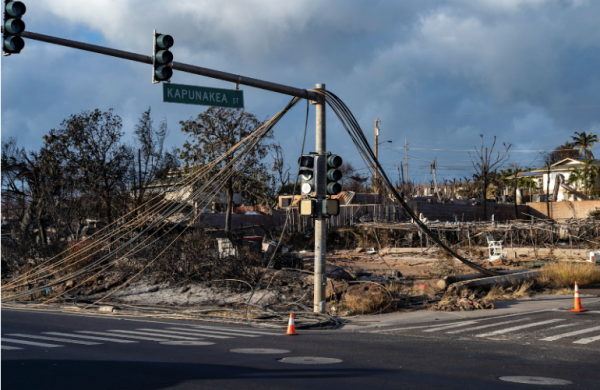On the morning of August 8, the citizens of Lahaina—a historic town in West Maui—bore witness to a brush fire that, in the next few weeks, would grow to swallow up the entirety of the small town, and ultimately burn through 10 square miles of the Hawaiian island of Maui.
The origins of the fires are widely debated but have generally been narrowed down to two primary causes: weather conditions and electrical power. With 90% of the state receiving less rainfall than it did a century ago, Hawaii has long been afflicted by severe drought and dryer vegetation, a combination which fosters the conditions for a wildfire to rapidly spread
However, weather conditions alone cannot explain the scope and severity of the wildfires in Maui: the Hawaiian Electric Company has become a recent target of blame due to the company’s inability to de-energize its power lines given the unsafe weather conditions.

The company itself takes responsibility for the first Lahaina fire but denies culpability for any of four following conflagrations that occurred—instead choosing to attribute the severity and exacerbation of the later fires to the inaction of the Hawaiian government. Although the conversation of whether the government or the company is the biggest perpetrator of the wildfires is up for debate, it is clear that negligence by both parties was an all-around issue.
Thus, Maui, a place that has long been characterized as the Hawaiian island with the greatest biodiversity, now is forced to watch as its jungles, rainforests, and beaches turn black with ash. However, the environmental impact of the wildfires is projected to cause exponentially more damage than simply burning through Maui’s flora and fauna.
Because the majority of demolished areas were residential, the conflagrations burned down houses, cars, and buildings—all of which left toxic contaminants in their wake.

Unfortunately, the toxic contaminants released by the burned infrastructure contain the carcinogenic (cancer-causing) chemical, benzene, recently discovered to be found in Lahaina’s public water supply—threatening the health of its citizens. Further, the number of buildings the conflagration burned down will cause Maui’s water system to accumulate pollution from burnt areas in its water delivery pipes —which ultimately leads to toxic pollutants traveling all throughout Maui’s water system and circulating toxins across the island.
In addition to the polluted water, air can also get contaminated by the same pollutants plaguing marine biomes.

Collectively, the wildfires burned through various types of electronics, all of which contain chemicals—such as lead and mercury—that form hazardous byproducts. This means relief services and local authorities hold the responsibility of both cleaning up all rubble and waste and launching rebuilding initiatives, in a manner that prevents civilian exposure to these potential carcinogens and limits long-term respiratory illnesses.
The fires have also caused substantial damage to the Hawaiian economy, through direct losses and disruptions in Hawaiian tourism. The economic losses resulting have been estimated as between $4 billion to $6 billion, largely due to the widespread destruction of Maui’s infrastructure and businesses.
Maui’s economy is especially reliant on tourism, even compared to the rest of Hawaii, with around 70% of every dollar coming from the industry. Naturally, with tourists fleeing, businesses lose a chunk of their consumers, and the government has lost a significant part of its revenue. For many economists, this disruption has highlighted the long-term dangers of Hawaii’s over-reliance on tourism, signaling the need to pursue economic diversification.

In response to the wildfire, the federal government began to coordinate relief efforts with the Hawaiian government. President Biden issued a disaster declaration following the beginning of the fires, allowing the government to send emergency supplies to Hawaii. The Federal Emergency Relief Agency (generally known as FEMA) has issued a total of $8.5 million to Hawaii in order to assist recovery efforts. Victims of the fire are additionally able to receive a one-time payment of $700 to assist their recovery.
Despite these efforts, the scale of the resulting destruction and the massive number of victims has led many to criticize the state and federal government’s response to the disaster. Aid to residents of the Island came days late, leaving many people desperate for basic necessities. Victims were often forced to rely on local relief efforts which, while being beneficial, were insufficient and without sufficient funding.
Similar feelings have been expressed by many first responders, who were overburdened in attempting to mitigate the effects of the fires, and lacking in federal support.
While FEMA’s eventual response was gladly welcomed, it has not addressed many of the long-term impacts of the fire. Maui has some of the highest living costs in the nation leading many survivors to wonder how they will be able to afford shelter.

However, there remains significant hope for Hawaiian citizens. In a move to prevent a government shutdown, congress passed a bipartisan funding bill that includes $16 billion in disaster relief. A significant portion of this will be allocated to Hawaii.
Regardless, even after the federal government and outside relief services have both pledged their support to build Maui back up—the island continues to suffer the aftermath of the wildfires. Families continue to grieve the 97 civilians who perished, authorities continue to search for the 66 citizens still recorded as missing, and the 6,000 displaced residents continue to find somewhere else to call home. Fortunately, the first steps to rebuilding the region have recently been taken, as Lahaina just allowed citizens back into the town at the end of September. However, the long-term effects for the future of Maui and its citizens still remain to be seen.

